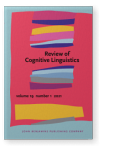Vol. 19:1 (2021) ► pp.51–79
Between commitment and certainty
A cognitive semantic approach to an I promise construction in English
In accord with Verhagen’s (1996) insights regarding epistemic uses of the predicator promise (e.g., Tomorrow promises to be a fine day), this paper identifies another type of these epistemic uses. It focuses on constructional cues in complex-clause utterances of the form I promise X: whether or not the subject of the embedded clause X is congruent with ‘I’ in the main clause and whether the tense of X is past or non-past. It investigates how it is used epistemically, especially in its colloquial uses; how the constructional cues (the kind of subject and the tense information) influence its construal; and how the different conceptual structures underlying the construals of the commissive and the epistemic modal senses of the construction can be modeled within Mental-spaces theory. It also discusses that the conceptual structures may be differently reified cross-linguistically briefing on the Korean constructs yaksokha- ‘(I) promise’ and cangtamha- ‘(I) assure’.
Article outline
- 1.Introduction
- 2.Preliminaries
- 2.1On the predicator promise
- 2.2Viewpoints and mental spaces
- 3.The I promise construction: Data and types
- 3.1When the embedded subject is a first person
- 3.2When the embedded subject is not a first person
- 4.Modeling conceptual structures behind construals
- 4.1The construal of the speaker’s commitment
- 4.2The construal of the speaker’s epistemic stance
- 5.Discussion
- 5.1Beyond the numbers: The conceptual relationship between commitment and certainty
- 5.2Cross-linguistic outlook: Equivalents in Korean
- 6.Conclusion
- Acknowledgements
- Notes
- Glossing abbreviations
-
References
